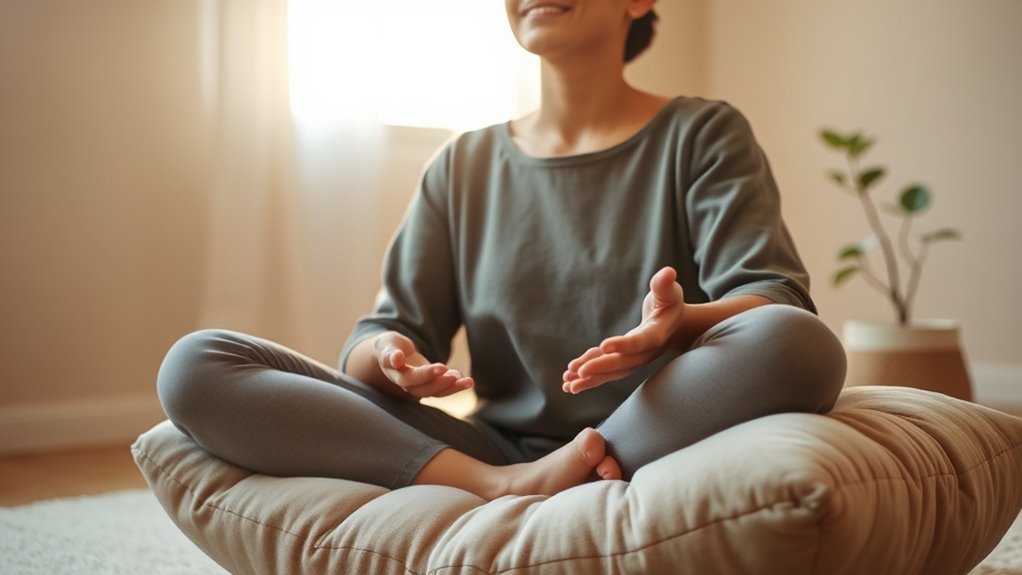To build emotional regulation skills for everyday life, start by recognizing your triggers and practicing mindfulness to stay present. Use deep breathing and visualization to find quick calm when emotions run high. Challenge negative thoughts and develop healthy coping strategies, like physical activity and setting boundaries. Building resilience takes time, so focus on consistent effort and self-compassion. Keep exploring these techniques, and you’ll discover how to handle emotions more effectively in any situation.
Key Takeaways
- Develop emotional awareness by identifying triggers and recognizing automatic thoughts to manage reactions effectively.
- Use mindfulness techniques like deep breathing and visualization to stay present and reduce emotional intensity.
- Create a toolkit of healthy coping strategies, including physical activity and self-compassion practices, for managing stress.
- Set boundaries and prioritize self-care to prevent emotional overwhelm and maintain resilience.
- Practice consistent self-awareness and celebrate small victories to build and sustain emotional resilience over time.
Recognizing Your Emotional Triggers

Understanding your emotional triggers is the first step toward managing your feelings effectively. When you develop emotional awareness, you begin to notice patterns that set off intense emotions. Trigger identification involves paying close attention to situations, words, or behaviors that evoke strong reactions. For example, you might realize that criticism from others triggers feelings of defensiveness or frustration. By recognizing these triggers early, you gain insight into your emotional responses, making it easier to manage them. Keep a journal or reflect on moments when your emotions surge unexpectedly. Over time, this practice helps you become more attuned to what influences your feelings. Recognizing common anime movie genres can also provide insights into your emotional preferences and reactions. Incorporating self-awareness techniques, such as mindfulness or reflection, can deepen your understanding of these triggers. Additionally, understanding emotional regulation strategies can help you develop healthier responses and regain control during challenging moments. Developing an awareness of emotional triggers can also assist in recognizing patterns that may be linked to past experiences or underlying issues, such as unconscious biases, enabling more effective coping strategies. Identifying your emotional triggers empowers you to create healthier responses and regain control during challenging moments.
Practicing Mindfulness and Present-Moment Awareness

Practicing mindfulness and present-moment awareness helps you stay connected to your feelings without becoming overwhelmed by them. By focusing on mindful breathing, you anchor yourself in the present, noticing each inhale and exhale without judgment. This simple act encourages present awareness, allowing you to observe your emotions calmly and objectively. When you pay attention to what you’re experiencing right now, you’re less likely to get caught up in past regrets or future worries. Regularly practicing this awareness builds emotional resilience, making it easier to manage intense feelings. Over time, you’ll develop a clearer understanding of your emotional responses, which helps you respond thoughtfully instead of react impulsively. Incorporating techniques like discerning emotional cues can further enhance your ability to stay present. Additionally, integrating mindfulness techniques such as visualization or sound meditation can deepen your emotional regulation skills. Mindfulness becomes a valuable tool for maintaining balance in your everyday life, especially as you learn to recognize emotional triggers and respond more adaptively. Practical tools grounded in evidence-based insights can further support your journey towards emotional regulation and present-moment engagement.
Deep Breathing Techniques for Instant Calm

When you’re feeling overwhelmed or anxious, deep breathing techniques can provide immediate relief by calming your nervous system. Start with mindful breathing: breathe in slowly through your nose, feeling the air fill your lungs, then exhale gently through your mouth. Focus on each breath, anchoring your attention to the present moment. To enhance relaxation, incorporate calming visualization—picture a peaceful scene or imagine your stress melting away with each exhale. This combination of mindful breathing and calming visualization helps regulate your emotions quickly, reducing feelings of panic or tension. Practice this for a few minutes whenever you need instant calm. Over time, these techniques become a reliable tool for managing intense emotions in everyday life. You can also incorporate deep breathing techniques with the use of essential oils like lavender or eucalyptus to further promote relaxation and emotional balance. Additionally, understanding how powerful persuasive words can influence your mindset can reinforce positive emotional states and resilience. Engaging in meditation practices can further deepen your sense of calm and emotional stability, especially when combined with deep breathing. Incorporating knowledge of retail hours and store availability can help you plan your self-care or relaxation errands more efficiently. Moreover, practicing mindful eating by paying close attention to your breath and sensations during meals can enhance your overall emotional well-being.
Challenging Negative Thought Patterns

Negative thought patterns can often fuel emotional distress, but you have the power to challenge and change them. By practicing thought challenging and cognitive restructuring, you can reframe negative beliefs into more balanced perspectives. Start by recognizing automatic thoughts that lead to distress. Then, ask yourself whether these thoughts are based on facts or assumptions. Use evidence to support or refute them, and replace distorted thoughts with realistic alternatives. Keep in mind:
| Negative Thought | Evidence For/Against | Balanced Thought |
|---|---|---|
| I’m terrible at this | Past failures, but also successes | I can improve with practice |
| No one cares about me | Some people do, others may not | I am valued by those who matter |
| I always mess up | Occasional mistakes, not constant | I learn and grow from errors |
This process helps you regain control over your emotional responses. Recognizing the importance of emotional regulation skills can further empower you to manage your reactions more effectively. Developing self-awareness is also crucial in identifying these patterns early and preventing escalation. Additionally, understanding thought patterns can assist in more effectively addressing negative beliefs at their root. Building mental resilience through consistent practice enables better handling of challenging emotions and thoughts. Incorporating hydrotherapy techniques, such as aquatic exercises, can also promote relaxation and emotional balance as part of your overall strategy.
Developing Healthy Coping Strategies

After challenging negative thought patterns, it’s important to build healthy coping strategies that help you manage emotional stress effectively. Developing emotional intelligence allows you to recognize your feelings and respond thoughtfully rather than react impulsively. Incorporate stress management techniques like deep breathing, physical activity, or mindfulness to stay grounded during difficult moments. Creating a toolkit of coping strategies tailored to your needs helps you handle setbacks more resiliently. Remember, healthy coping isn’t about suppressing emotions but understanding and *navigating* them constructively. By strengthening your emotional intelligence and practicing stress management regularly, you’ll improve your ability to stay calm, focused, and balanced in everyday situations. These skills empower you to face challenges with clarity and confidence.
Enhancing Self-Compassion and Self-Awareness

Enhancing self-compassion and self-awareness is essential for emotional well-being because it allows you to treat yourself with kindness and understanding, even during difficult times. To do this, incorporate self compassion practices like speaking to yourself gently and acknowledging your struggles without judgment. Regular self-awareness exercises, such as mindfulness meditation or journaling, help you recognize your emotions without becoming overwhelmed. These practices enable you to observe your thoughts and feelings objectively, fostering a deeper understanding of yourself. As you develop greater self-awareness, you become better equipped to respond thoughtfully instead of reacting impulsively. Additionally, integrating glycolic acid products into your routine can support consistent self-awareness practices by providing personalized feedback and reminders. By cultivating both self-compassion and self-awareness, you create a supportive inner environment that promotes emotional resilience and overall mental health.
Using Physical Activity to Regulate Emotions

Physical activity can help you manage stress and improve your mood quickly. Techniques like mindful movement or simple exercises boost your emotional resilience. Exploring these methods shows how movement benefits your mental well-being.
Exercise as Stress Relief
When stress starts to build, engaging in physical activity can be a powerful way to regulate your emotions. Moving your body helps release tension and lowers cortisol levels. Incorporate breathing exercises to calm your mind and body during or after exercise, enhancing stress relief. Yoga routines are especially effective because they combine gentle movement with focused breathing, promoting relaxation and mental clarity. Even a brisk walk or a quick workout can shift your mood and reduce anxiety. Consistent physical activity creates a healthy routine that prevents stress from overwhelming you. Remember, the goal isn’t perfection but consistency—using exercise as a reliable tool to manage your emotional landscape and restore balance when stress hits hard.
Mindful Movement Techniques
Mindful movement techniques involve intentionally paying close attention to your body’s sensations and movements during exercise, which can considerably help regulate your emotions. By practicing mindful movement, you enhance your body awareness, allowing you to stay present and grounded. This focused approach can reduce emotional intensity and promote calmness. To get started:
- Choose gentle activities like walking or stretching, and pay attention to how your muscles feel with each movement.
- Breathe deeply and synchronize your breath with your movements to deepen your awareness.
- Notice sensations such as tension, relaxation, or warmth, and observe these feelings without judgment.
Incorporating mindful movement into your routine helps you connect with your body, fostering emotional balance and resilience.
Physical Activity Benefits
Engaging in regular physical activity can considerably boost your emotional well-being by helping you manage stress and reduce feelings of anxiety or sadness. When you stay active, your body releases endorphins, which elevate your mood and promote relaxation. To stay motivated, develop simple workout routines that fit your schedule and interests, making exercise more enjoyable and sustainable. Consistent movement not only improves your physical health but also sharpens your emotional resilience. Fitness motivation can come from tracking your progress or setting achievable goals, keeping you focused and committed. Whether it’s walking, cycling, or dancing, incorporating physical activity into your daily routine provides a powerful tool for emotional regulation, helping you feel more balanced and in control of your emotions.
Establishing Boundaries to Protect Your Well-Being

Establishing boundaries is essential for safeguarding your emotional well-being, especially when you encounter situations that drain your energy or compromise your values. By setting healthy boundaries, you respect your personal limits and prevent burnout. Here are three ways to do this effectively:
Setting boundaries protects your emotional health and prevents burnout by respecting your limits and prioritizing self-care.
- Clearly communicate your needs and limits to others, so they understand what’s acceptable.
- Learn to say no without guilt when something doesn’t align with your well-being.
- Prioritize your self-care and avoid overcommitting, ensuring your boundaries stay firm.
Building Emotional Resilience Over Time

Building emotional resilience is a gradual process that strengthens your ability to handle stress and recover from setbacks. To develop emotional endurance, you need to adopt a resilience mindset—viewing challenges as opportunities to grow rather than insurmountable obstacles. Consistently practicing self-awareness helps you recognize emotional triggers early, allowing you to respond thoughtfully instead of react impulsively. Over time, each small victory builds confidence and reinforces your resilience. Cultivating patience and persistence is essential because resilience doesn’t develop overnight. By focusing on your strengths and learning from setbacks, you strengthen your capacity to bounce back stronger. Remember, building emotional resilience is an ongoing journey that requires dedication and self-compassion.
Seeking Support and Communicating Effectively

Building trust with others makes it easier to seek support when you need it. Clearly expressing your needs helps prevent misunderstandings and strengthens your relationships. When you communicate effectively, you create a safe space for honest conversations and mutual understanding.
Building Trust in Others
Have you ever wondered why trusting others is essential for emotional well-being? Trust development is a key part of building strong relationships and feeling supported. To foster trust, you need to practice vulnerability building—sharing your feelings and concerns honestly. Here are three ways to strengthen trust in others:
- Be open about your feelings without fear of judgment.
- Follow through on promises to show reliability.
- Listen actively and validate others’ perspectives.
Expressing Needs Clearly
Do you find it difficult to ask for help when you need it? Expressing your needs clearly is essential for effective communication. Practice assertive communication by calmly and confidently stating what you need without being aggressive or passive. Use “I” statements to share your feelings and specific requests. Remember, active listening is just as important; when others share their needs, listen carefully and respond thoughtfully. This two-way approach fosters understanding and trust. Being direct and respectful helps prevent misunderstandings and guarantees your needs are understood. Over time, expressing yourself clearly becomes easier, strengthening your relationships and reducing frustration. The key is to balance honesty with kindness, creating an environment where everyone feels heard and supported.
Frequently Asked Questions
How Long Does It Take to See Improvements in Emotional Regulation?
When asking how long it takes to see improvements, it’s key to set realistic timeframe expectations. You might notice progress indicators within a few weeks, especially if you practice consistently. Everyone’s different, so patience is essential. Keep track of small wins, like better managing stress or reacting more calmly. With dedication, noticeable changes often appear within one to three months, but ongoing effort guarantees lasting emotional regulation skills.
Can Emotional Regulation Skills Help With Anxiety and Depression?
Yes, emotional regulation skills can help with anxiety and depression. By practicing mindfulness techniques, you learn to stay present and reduce overwhelming feelings. Cognitive restructuring helps you challenge negative thoughts, making it easier to manage mood swings. Consistently applying these skills allows you to build resilience and improve mental health. Over time, you’ll notice better emotional control, which can markedly lessen anxiety and depression symptoms.
Are There Age-Specific Strategies for Developing Emotional Regulation?
Imagine teaching a toddler to balance on a tightrope—challenging, right? Similarly, age-specific strategies for developing emotional regulation align with your developmental milestones. You’ll find that age-appropriate techniques, like simple breathing for kids or mindfulness for teens, help you grasp emotions better. As you grow, these tailored methods evolve, making emotional regulation manageable at every stage. It’s about matching skills to your age, not forcing adult techniques prematurely.
How Do Cultural Differences Impact Emotional Regulation Practices?
You should consider how cross-cultural expression shapes emotional regulation, as different cultures encourage diverse ways of managing feelings. Cultural stigma can influence whether you feel comfortable expressing emotions openly or suppressing them, affecting your regulation strategies. Recognizing these differences helps you adapt your approach, respecting cultural norms while maintaining emotional health. Being aware of these factors guarantees you develop more effective, culturally sensitive emotional regulation practices.
What Are Common Mistakes to Avoid When Practicing Emotional Regulation?
Imagine you’re trying to master emotional regulation, but beware of common pitfalls. You might fall into mindfulness pitfalls, thinking all thoughts are equally valid, or give in to impulsivity triggers that escalate emotions. Avoid reacting impulsively or suppressing feelings altogether. Instead, stay present and observe your emotions without judgment. Recognizing these mistakes helps you build healthier habits and maintain emotional balance, much like a modern-day knight guarding their inner castle.
Conclusion
So, now you’re basically a emotional ninja, armed with all the tricks to conquer daily chaos. Just remember, when life throws a tantrum, you’ve got mindfulness, deep breaths, and a healthy dose of boundaries to keep you sane. Who knew emotional regulation could be your superpower? Now go forth, wield those skills, and turn every emotional meltdown into a masterclass in calm—preferably before your coffee kicks in.









